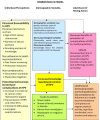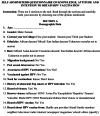An Examination of Knowledge, Attitudes, and Intentions Related to Human Papillomavirus (HPV) Vaccination Among Undergraduate Students in Saint Lucia
- PMID: 40296980
- PMCID: PMC12037195
- DOI: 10.7759/cureus.81426
An Examination of Knowledge, Attitudes, and Intentions Related to Human Papillomavirus (HPV) Vaccination Among Undergraduate Students in Saint Lucia
Abstract
Objective: In the Caribbean, cancer ranks as the second leading cause of mortality. Without interventions, the incidence is predicted to increase by 66% within the next decade, with over 56,000 women being diagnosed with cervical cancer annually and more than 28,000 succumbing to the disease. However, lifesaving prevention and treatment measures are available. This research sought to explore potential differences in knowledge, attitudes, and willingness to receive human papillomavirus (HPV) vaccinations among male and female undergraduate students at a chosen Community College in St. Lucia.
Methods: This investigation utilized a descriptive, quantitative, and cross-sectional approach. Participants (n = 100) were chosen through random sampling and completed 59-item self-administered questionnaires addressing the targeted variables. Multivariable statistical techniques were employed to determine independent predictors of HPV vaccine acceptance among participants.
Results: Despite recognizing the associated risks, the findings highlighted a substantial deficit in public health promotion efforts. First, although HPV is widespread in St. Lucia and causes cancer in both genders, there is insufficient awareness-raising about HPV. Second, the vaccine is not accessible in St. Lucia. Third, the high expenses associated with the vaccine ($500 US) and HPV test ($275 EC) hinder obtaining them. Finally, HPV vaccine uptake was minimal among participants; only seven out of 100 had been vaccinated and received it in the US. Despite low vaccine uptake, 53% acknowledged the urgent need for vaccination.
Conclusions: Integrating HPV vaccination within healthcare and HPV awareness initiatives can yield positive outcomes in mitigating cancer's long-term impact on St. Lucia's male and female populations. Educational programs could prove advantageous in enhancing knowledge about HPV and vaccinations.
Keywords: cervical cancer; hpv vaccination; human papilloma virus; pap smear; sexually transmitted infection (sti).
Copyright © 2025, Daniel et al.
Conflict of interest statement
Human subjects: Consent for treatment and open access publication was obtained or waived by all participants in this study. The University of the West Indies (UWI) Campus Ethics Committee issued approval CEC209/05/16. I am pleased to advise that your application for research on the above-captioned topic has been approved on behalf of the Campus Ethics Committee. Animal subjects: All authors have confirmed that this study did not involve animal subjects or tissue. Conflicts of interest: In compliance with the ICMJE uniform disclosure form, all authors declare the following: Payment/services info: All authors have declared that no financial support was received from any organization for the submitted work. Financial relationships: All authors have declared that they have no financial relationships at present or within the previous three years with any organizations that might have an interest in the submitted work. Other relationships: All authors have declared that there are no other relationships or activities that could appear to have influenced the submitted work.
Figures





Similar articles
-
Knowledge and willingness of parents towards child girl HPV vaccination in Debre Tabor Town, Ethiopia: a community-based cross-sectional study.Reprod Health. 2022 Jun 10;19(1):136. doi: 10.1186/s12978-022-01444-4. Reprod Health. 2022. PMID: 35689288 Free PMC article.
-
Knowledge, Attitudes, and Perceptions Towards Human Papillomavirus (HPV) Vaccination Among Adult Women in Primary Health Care Centers in Makkah, Saudi Arabia.Cureus. 2023 Aug 26;15(8):e44157. doi: 10.7759/cureus.44157. eCollection 2023 Aug. Cureus. 2023. PMID: 37638260 Free PMC article.
-
Human papillomavirus vaccination: assessing knowledge, attitudes, and intentions of college female students in Lebanon, a developing country.Vaccine. 2015 Feb 18;33(8):1001-7. doi: 10.1016/j.vaccine.2015.01.009. Epub 2015 Jan 15. Vaccine. 2015. PMID: 25597945
-
Knowledge, attitudes, and practices towards HPV vaccination among reproductive age women in a HIV hotspot in the US.PLoS One. 2023 Jan 19;18(1):e0275141. doi: 10.1371/journal.pone.0275141. eCollection 2023. PLoS One. 2023. PMID: 36656804 Free PMC article.
-
The cold truth about robotics research in the United Kingdom as a Caribbean woman.Sci Robot. 2024 Dec 4;9(97):eadu2844. doi: 10.1126/scirobotics.adu2844. Epub 2024 Dec 4. Sci Robot. 2024. PMID: 39630877 Review.
References
LinkOut - more resources
Full Text Sources
Research Materials
